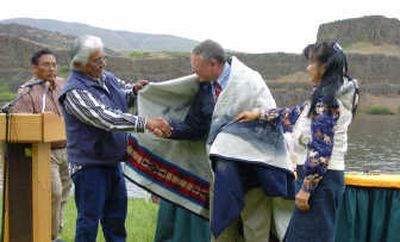Four tribes, feds sign salmon pact

DALLESPORT, Wash. – The leaders of four American Indian tribes and federal hydropower regulators on Friday celebrated a landmark agreement intended to improve fish runs in the Pacific Northwest, just days before a deadline for a new regional salmon recovery plan.
Native prayers and songs, congratulatory gifts and emotional speeches were offered all around at a traditional salmon bake at Columbia Hills State Park, overlooking the Columbia River. Tribal representatives remembered the role of salmon and steelhead in their territory and expressed hope the accord will restore fish to the river and its tributaries.
However, a fifth tribe has so far refused to sign off on the deal, the state of Oregon remains unconvinced, and environmental groups fear the agreement doesn’t go far enough to protect endangered and threatened fish in the Columbia River Basin long term.
Still to be determined: Whether the accord will stand pending a judge’s ruling on whether the latest recovery plan meets the requirements of the Endangered Species Act.
Federal agencies have struggled to produce a plan for helping salmon survive their migrations over hydroelectric dams. A judge threw out two previous proposals, known as biological opinions; the third is due Monday.
Friday’s agreement commits federal agencies to give the tribes $900 million to spend toward salmon recovery in exchange for dropping out of a lawsuit challenging dam operations.
The tribes and bands from two reservations each in Washington and Oregon have agreed to the deal: the Yakama Nation, Colville, Warm Springs and Umatilla.
“What’s being done here is best for the resource. It’s best to put our efforts into the river, rather than the courtroom,” said Ralph Sampson Jr., chairman of the Yakama Nation. “From here, we’re actually doing something about habitat restoration and increasing salmon populations.”
Thirteen species of salmon and steelhead that pass over the dams are threatened or endangered. On Thursday, NOAA Fisheries declared an economic disaster for the West Coast salmon fishery, opening the door for federal aid.
Antone Minthorn, Umatilla chairman, said the 10-year agreement allows biologists to monitor improvements through two life cycles of salmon to evaluate their effectiveness and determine a path forward. The goal, he said, is to see 5 million fish return.
“In our experience, we have found the cooperative approach to be most effective and most sustainable,” Minthorn said. “In 10 years, I believe we will have made a difference.”
The Yakama will receive $330 million, the Colville $200 million, the Umatilla $150 million and Warm Springs about $80 million. The Columbia River Inter-Tribal Fish Commission also agreed and will get about $90 million. The money will largely go toward fish hatchery improvements and habitat restoration. In Colville country, the money will restore water and fish to Salmon Creek, dry for decades due to irrigation demand.
The Bonneville Power Administration, a regional power agency based in Portland, says the agreement should raise wholesale electric rates by 2 percent to 4 percent.
The projects may be well and good for habitat restoration, said Nicole Cordan of Save Our Wild Salmon Coalition. But the lawsuits are about salmon recovery, she said, and the judge is expected to rule on science.
“It’s really about whether those projects, with this biological opinion, actually get you to salmon recovery,” she said. “We think the answer is clear, and the answer is no.”
Idaho also signed an agreement with federal regulators worth $65 million, and Montana agreed to terms for $15.5 million on Thursday night. Washington state also supports the accords.
Oregon Gov. Ted Kulongoski has expressed concerns the agreements don’t satisfy the government’s obligations and won’t be enough to put the region on the path to recovery of abundant wild salmon populations.
The Nez Perce tribe, meanwhile, remains in negotiations with federal hydropower regulators – BPA, which sells the power produced by the dams; the U.S. Bureau of Reclamation, which operates the dams; and the U.S. Army Corps of Engineers.
The Idaho tribe has wider concerns, notably four dams on the Snake River, said Gary Greene, a member of the Nez Perce Tribal Executive Committee.
“We respect each tribe’s sovereignty and the decisions they have to make with regards to their people and their natural resources,” Greene said. “But we’ve always stood by the words from the best scientists, and that is removal of the dams. So we’ve taken that stance too.”
The remaining tribes and the Fish Commission have chosen not to limit their focus on dam breaching, said Charles Hudson, Fish Commission spokesman. And in the meantime, 200 projects over a vast geographic area can get off the ground, putting the focus on habitat restoration.
“Some people, for 20 or 30 years, have known nothing but conflict on this issue,” Hudson said. “We’re up to the job of convincing people to get familiar with these agreements before they judge them.”